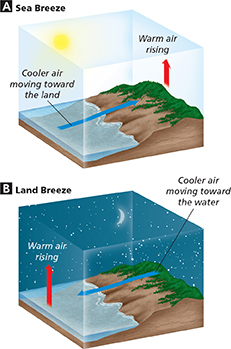Wind
What happens when you open a vacuum-packed can of chips? You hear a rush of air, which is the sound of air moving from the high-pressure area outside the can to the low-pressure area inside the can. A similar process occurs in the atmosphere.
Air naturally flows from areas of higher pressure to areas of lower pressure. This flow is wind, which is the mainly horizontal movement of air.  Winds are caused by differences in air pressure. Larger pressure differences produce stronger winds.
Winds are caused by differences in air pressure. Larger pressure differences produce stronger winds.
Differences in air pressure are often caused by the unequal heating of Earth's surface. As you've learned, the atmosphere is warmed largely by reradiation from Earth's surface below it. As air is heated, it expands. As it becomes less dense, air rises. Cooler, denser air flows in to replace it. This process occurs on both local and global scales, producing local and global winds.
Local Winds
On a hot summer day, there is often a cool breeze blowing in from the water to the beach. This breeze is an example of a local wind, a wind that blows over a short distance. Local winds are caused by the unequal heating of Earth's surface within a small region.
 The breezes that occur where land meets a large body of water are examples of local winds. Water has a higher specific heat than land, and therefore takes longer to heat up and cool down. During the day, the sun heats the land more quickly than it heats the water. The air above the land becomes warmer than the air above the water. The warm air expands and rises, creating a lower-pressure area above the land. The cooler air over the water flows toward the land, creating a sea breeze.
The breezes that occur where land meets a large body of water are examples of local winds. Water has a higher specific heat than land, and therefore takes longer to heat up and cool down. During the day, the sun heats the land more quickly than it heats the water. The air above the land becomes warmer than the air above the water. The warm air expands and rises, creating a lower-pressure area above the land. The cooler air over the water flows toward the land, creating a sea breeze.
At night, these temperature and pressure conditions are reversed, as Figure 12 shows. Land cools off more quickly than water. The cooler air over land has a higher density than the warmer air over water. The result is a land breeze, where cooler air over land moves toward water. Winds are named for the direction from which they originate—sea breezes begin over the ocean and land breezes begin over land.

In which direction does a land breeze blow?
Figure 12 Sea breezes and land breezes are local winds. A During the day, air pressure differences due to unequal heating cause a sea breeze. B At night, pressure differences are reversed, causing a land breeze. Comparing and Contrasting How are land breezes and sea breezes different?
 d
d




